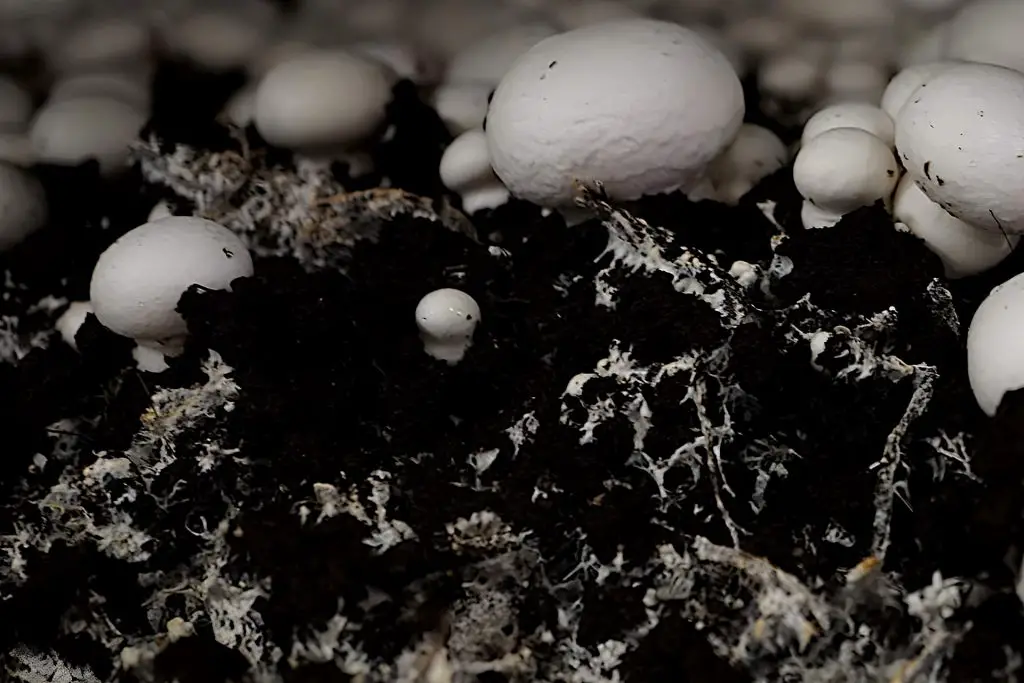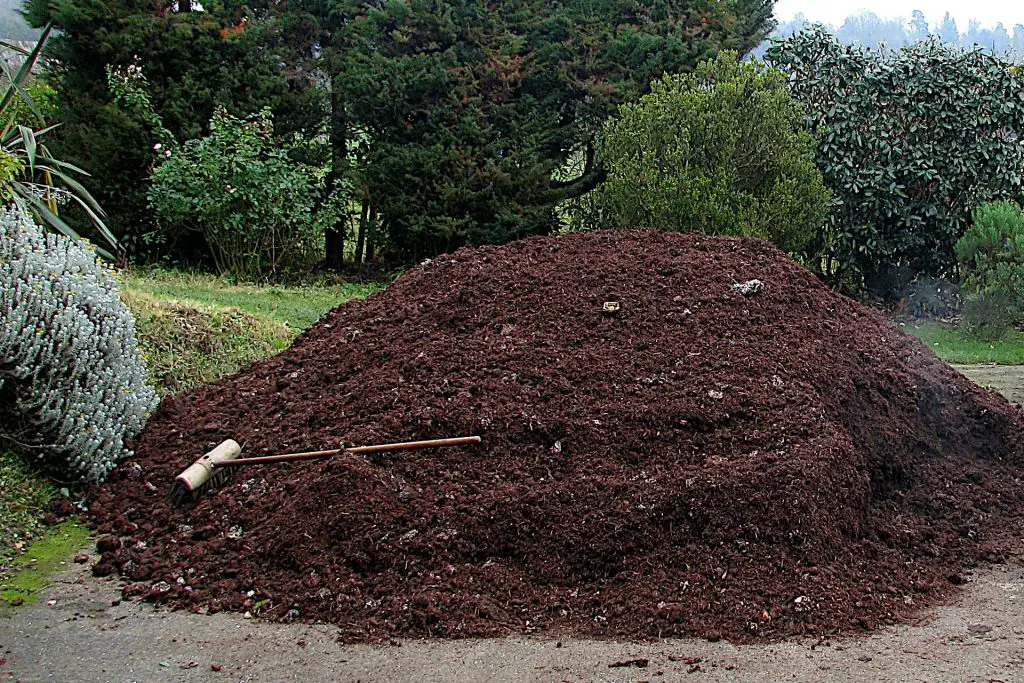What Is Mushroom Compost? Is it an Over-Hyped or Valuable Soil amendment?
Mushroom compost sometimes referred to as mushroom soil, is a popular soil amendment widely used by gardeners. It is derived from the used soil from mushroom farms, which provides it with a unique combination of nutrients and salts that many gardeners actively use to amend their soil to promote better plant growth.
In that mushroom compost is essentially a byproduct of mushroom farming, it is perhaps valuable to ask if its popularity is down to over-hype? Is it more than a useful way for mushroom producers to make money from a degraded material or does it actually have real benefits of use?
Mushroom compost is a class of organic plant fertilizer that releases its derived nutrients slowly. It is produced from the spent growing medium in which mushrooms are spawned. In general mushroom compost has high salt and calcium content with reduced nitrogen levels. However, there are numerous different recipes for mushroom growing mediums, so nutrient values for the resulting compost will vary slightly.
Different Growth Mediums for Mushrooms

As with regular compost, the actual makeup of the ingredients that go into making the growth medium that becomes mushroom compost varies considerably.
To get the best results from cultivating mushrooms, the growth medium needs to contain certain properties that contain starch, sugar, lignin, or cellulose as carbohydrates and a plentiful supply of nitrogen[1].
To ensure these properties are present the growth medium used is generally made up of manure and straw cured kept moist and turned every day for a few days until odorless. If manure is not readily available then corn, corn cobs, peat moss, and cured compost are used. Either a combination of sand, chalk, gypsum and even granite dust is then added to the mixture.
The reason for preparing the growth medium in this way is so the composting decomposition continues, feeding the mushrooms as they grow, with a soil temperature of around 75°F being considered ideal before dropping to around 60°F after three weeks or so.
The whole process takes around 60 days after which the degraded growth medium will be recycled as mushroom compost and the process starts again.
Nutrient Levels for Mushroom Compost
Like all soil amendments mushroom compost contains a spectrum of properties and nutrients that are beneficial to enhancing soil structure and improving nutrient levels.
However, in contrast to regular compost, these nutrient levels are somewhat depleted. The reason for this is that considerable amounts of the nutrients have been absorbed by the mushrooms during their growing process.
Nitrogen Levels in Mushroom Compost
Certain nutrients, particularly nitrogen are affected more than others. Nitrogen is essential for the growth of plants in relation to the structure, and the efficiency with which their metabolism processes food. Nitrogen also plays a role in how chlorophyll is produced. If there is inadequate levels of nitrogen in the soil, the plant won’t be able to produce sufficient food for it to achieve it’s growth potential.
However, lower levels of nitrogen can be advantageous. This can be the case if soil already has sufficient amounts, adding mushroom compost in these circumstances can help it retain levels over a period of several months because the compost releases it more slowly into the earth.
High Levels of Calcium
The addition of products, such as chalk to mushroom growth mix, results in a compost that has relatively high calcium levels. There are a number of plants, particularly vegetables and tomatoes that thrive in calcium-rich soil.
Elevated Hard Salt Levels in Mushroom Compost

One of mushroom compost’s main characteristics is its elevated hard salt level. It is important to note that salts come in two forms hard, salts and soluble (fertilizer) salts. Hard salts can damage your plants, particularly germinating plants.
Soluble salts add nutrients to the ground that are essential for plant growth, although, it is also true that too much of a specific nutrient can also damage plants. Overall, mushroom compost has a good balance of soluble salts 1.1-0.7-1.3. Potassium, Phosphorus, and Nitrogen (NPK). These ratios are similar to many other composts and are generally good nutrient levels.
High Alkaline Content in Mushroom Compost
Mushroom compost is alkaline in nature. It has a relatively high pH level compared to other amendments and when mixed with your soil, it has the potential to alter the soil’s overall pH level.
This could be a good thing or a bad thing, depending on the current pH of your soil. If it is acidic, mushroom compost can help rebalance it. However, although there are some plants that can cope with alkaline soil, the majority don’t, so it is best to maintain your soil at a relatively neutral pH level.
General Properties of Mushroom Compost
Mushroom compost has several properties that make it useful in certain circumstances. These included structural benefits, lack of beneficial organisms, and water retention.
Lack of Beneficial Microorganisms
Once it has been used to grow mushrooms the spent soil that is now mushroom compost is sterilized to kill off any harmful bacteria, weeds, or seeds that might have entered during the mushroom growing process. The process destroys all the beneficial organisms too.
This can be useful when used on a lawn as a fertilizer, or for combining with loan soil to create a potting mix. Being sterilized, it will not contain weed spores, pathogens, or fungi, which makes it good for these applications. However, if you need beneficial organisms to help prevent plants from becoming diseased, regular compost would either need to be used or added to the mix.
Water Retention
One of the most useful properties of mushroom compost is its ability to retain water. Water retention is particularly useful if a plant needs its soil to remain moist as it can allow you to water less frequently. This in turn could significantly reduce the amount of water that you use. Using it can be a good way to reduce your overall garden water consumption.
The negative side of water retention is the fact that if there is too much water in the ground it can result in root rot, which is likely to completely destroy the plant. There are also plants that prefer dryer conditions and the use of mushroom compost could adversely affect their growth if the soil remains moist.
Fungal infections can also result from water retention. This is something that you would need to watch particularly in terms of lawns.
Better Soil Structure
Despite the fact that it retains water so well mushroom compost can actually help with drainage. The fact that there is significant sand and chalk in mushroom compost allows the water, that is not absorbed, to pass through relatively easily. If you have dense clay soil, mushroom compost can be particularly effective at improving drainage.
When Should You Not Use Mushroom Compost?

The biggest issue concerning the use of mushroom compost is the elevated level of hard salts. These can inhibit or damage plants when they are germinating. This makes it a bad choice as a starter fertilizer and shouldn’t be used in the first phase of a plant’s growth.
The high levels of alkaline is also an issue. Alkaline soil is less soluble than neutral or even acid soils. As such a lot of plants can struggle in soils with higher pH levels. You should certainly never grow anything in mushroom compost without first mixing it with your soil at around 2:1 or 3:1 soil-to-compost ratio.
Does Mushroom Compost Deserve Its Hype?
There is an argument to say that mushroom compost is a bit of a vogue product. A useful way for mushroom growers to monetize the waste product. In truth, there is little that it can do that can’t be achieved with regular compost or fertilizer.
On the other side of this argument, it is a viable organic material that can be useful in certain growing situations, particularly for plants that like calcium, are good with alkaline soil, or benefit from the slow release of nutrients over a longer period of time.
On balance, it can certainly be a useful amendment, particularly if you want reduced nitrogen levels Much, however, depends on the circumstances of use.
Summary: What Is Mushroom Compost?
Mushroom compost is essentially the soil byproduct of growing mushrooms. There are hundreds of millions of tons of mushrooms consumed every year so there is a lot of it.
It certainly has some unique properties but these tend to be advantageous to only a few types of plants. Although it contains a good balance of soluble salts, the reduced level of nitrogen but high ‘hard’ salt levels prevent it from being used as a starter fertilizer.
Where it can be useful is as a maintenance amendment, helping refuel soil nutrient levels as the plants move from their initial growth phase. Established lawns are a particularly good use for mushroom compost.
Commonly Asked Questions
Do you need to dig in mushroom compost?
It depends on its use case. If you are using it as a lawn amendment, you would spread it on the surface after aerating. If you are using it for plants then you would mix it into your soil at a ratio of around 2:1 or 3:1.
Notes:
[1] Kansas State University Agricultural Experiment Station: Growing Mushrooms
